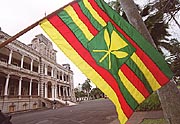By Yasmin Anwar
Advertiser Staff Writer
Upside-down or right-side up, the Hawaiian flag has long been a proud symbol of Hawaiian nationalism.
 |
| A copy of an "original" Hawaiian flag, believed destroyed by the British in 1843, is displayed at ‘Iolani Palace.
Bruce Asato • The Honolulu Advertiser |
But some say the flag, a hybrid of British and American symbolism, smacks too much of colonialism.
Enter Gene Simeona of Honolulu, who says he’s resurrected the "original" Hawaiian green, red and yellow striped flag, destroyed by British navy Capt. Lord George Paulet when he seized Hawai‘i for five months in 1843.
To Simeona, his newly unearthed flag says, "We are not British. We are kanaka maoli."
Simeona says he ran into a descendant of Lord Paulet on the grounds of ‘Iolani Palace in 1999 who told him the present Hawaiian flag is not the original.
That provoked Simeona to scour the Hawai‘i State Archives, where he found the design, then reproduced it. Since then, he and his business partner Stan Fonseca have been churning the emblem out in hopes that it’ll catch on as a fresh, noncolonial symbol of the restored Hawaiian kingdom.
According to Fonseca, the green in the flag represents the maka‘ainana (commoner) caste, the land and goodness; the red represents the landed konohiki who served the ali‘i, genealogy and strength; and the yellow represents the ali‘i, spirituality and alertness to danger.
At the center of the flag is a green shield bearing a coat of arms of the kanaka maoli, made up of kahili and crossed, pointed paddles that represent the voyaging history of Hawaiians.
Anna Marie Kahunahana, founder of A Call for Unity, which seeks to restore the independent Hawaiian nation, wholeheartedly endorses the flag.
"It represents who we are as a people and a nation," she said.
Others aren’t so sure about the design.
'Too reggae'
"I had it up for a while, but I took it down. It’s too reggae for me," said Aopohakuku Rodenhurst of the Nation of Ku spiritual group.
Still, Simeona and Fonseca are selling and giving away the flags faster than they can make them.
On Feb. 25, they will fly the "Hawaiian people’s flag" on the grounds of ‘Iolani Palace to commemorate "the crime" of Paulet’s fleeting takeover of Hawai‘i.
"Please leave your Union Jacks at home," said a recent notice announcing the event in the Hawaiian News.
British explorer Capt. George Vancouver originally presented Kamehameha I the islands’ first Union Jack in 1794.
Later the British and American emblems were blended. The nine stripes represented the major Hawaiian Islands and the archipelago. The Union Jack represented Britain’s historic protectorate relationship with Hawai‘i. After statehood, the stripes were reduced to eight bars.
Kekuni Blaisdell, a physician and leader of the independence group Ka Pakaukau, said perhaps it’s time for a flag that is void of colonial symbols.
But others say Hawaiians shouldn’t be in a rush to embrace the new flag without establishing its authenticity.
Peter Umialiloa Sai, a spokesman for the Council of Regency of the Hawaiian Kingdom, says when his organization first learned about Simeona’s flag a year ago, they conducted research to try to pinpoint its origin, but found no clues.
In the meantime, Sai said, they amassed extensive documentation validating the traditional Hawaiian flag as the official emblem of the former Hawaiian kingdom.
"Regardless of that colonial symbolism, it is our national flag, and you just can’t discard it because it has some negative stigmatism," he said.
As for the new flag, he said, they’ll stay open-minded, but "we’re not going to give it any more life than it deserves."
[back to top] |

